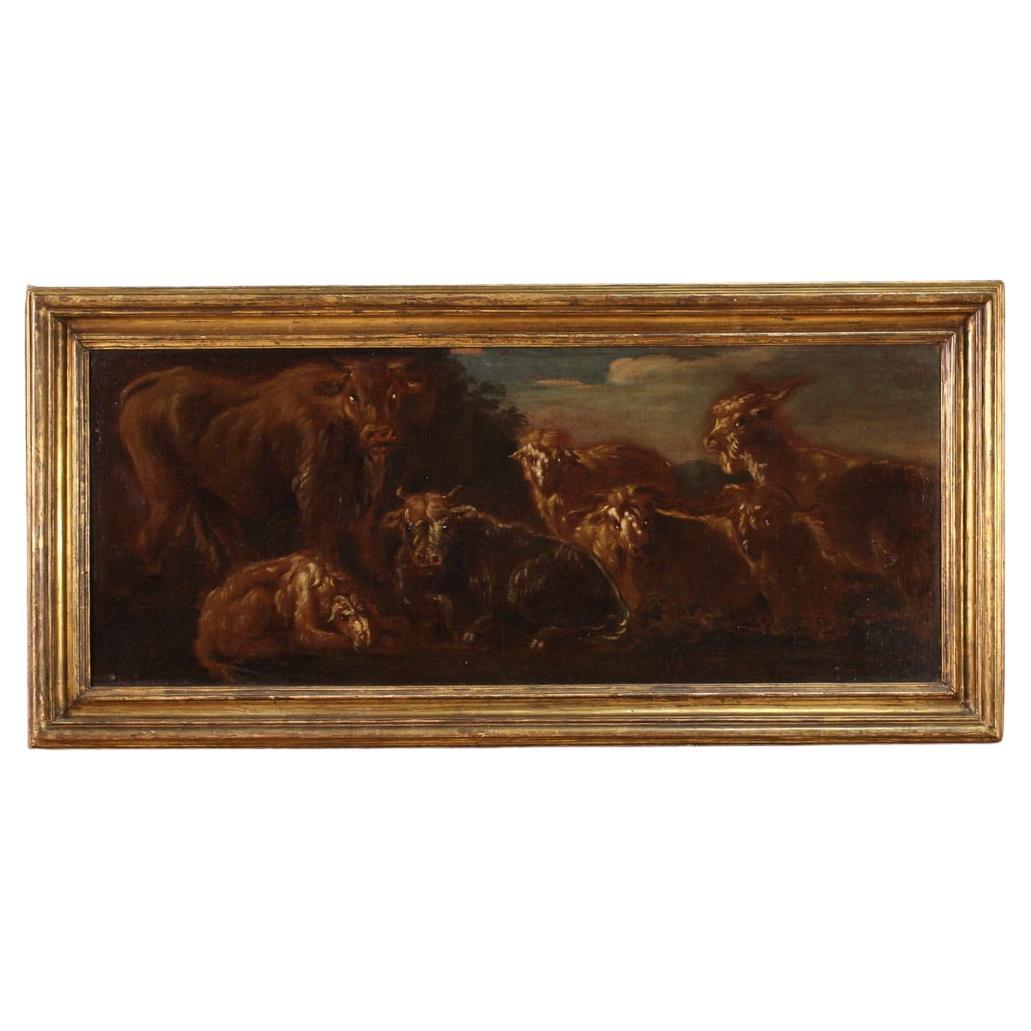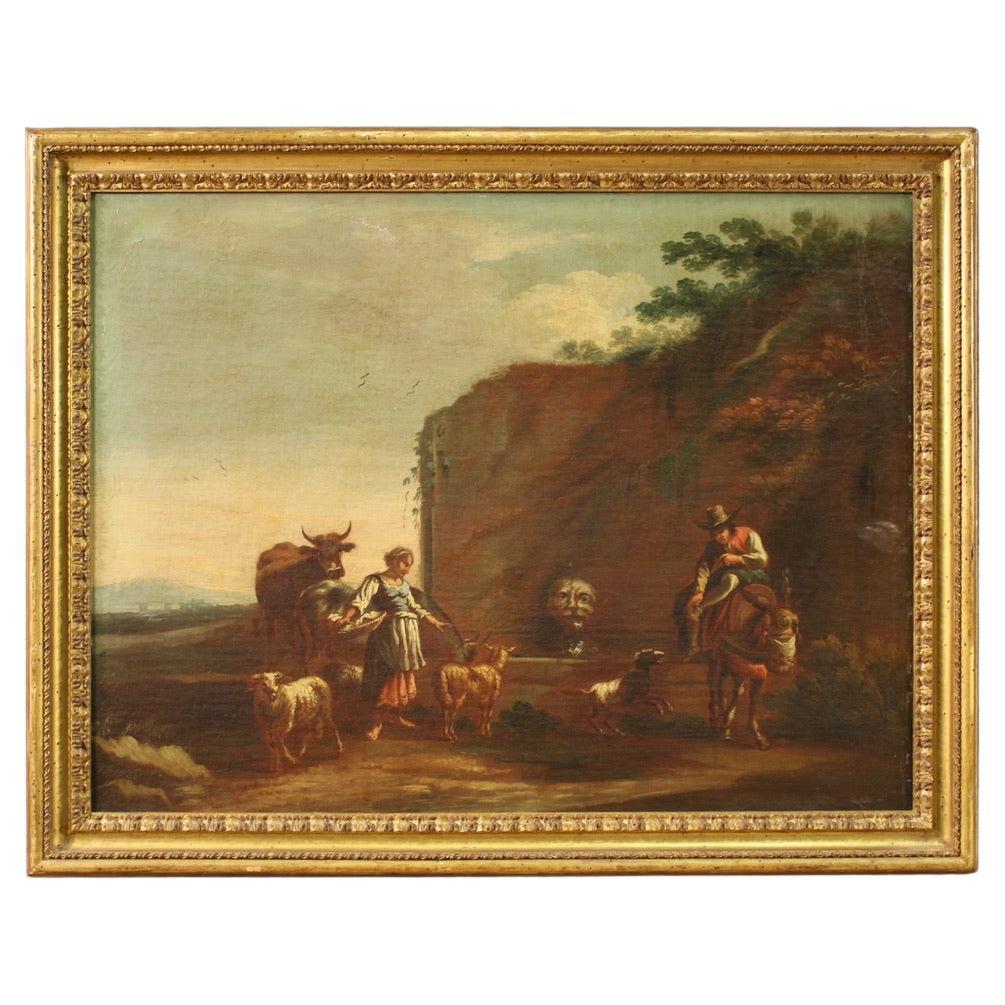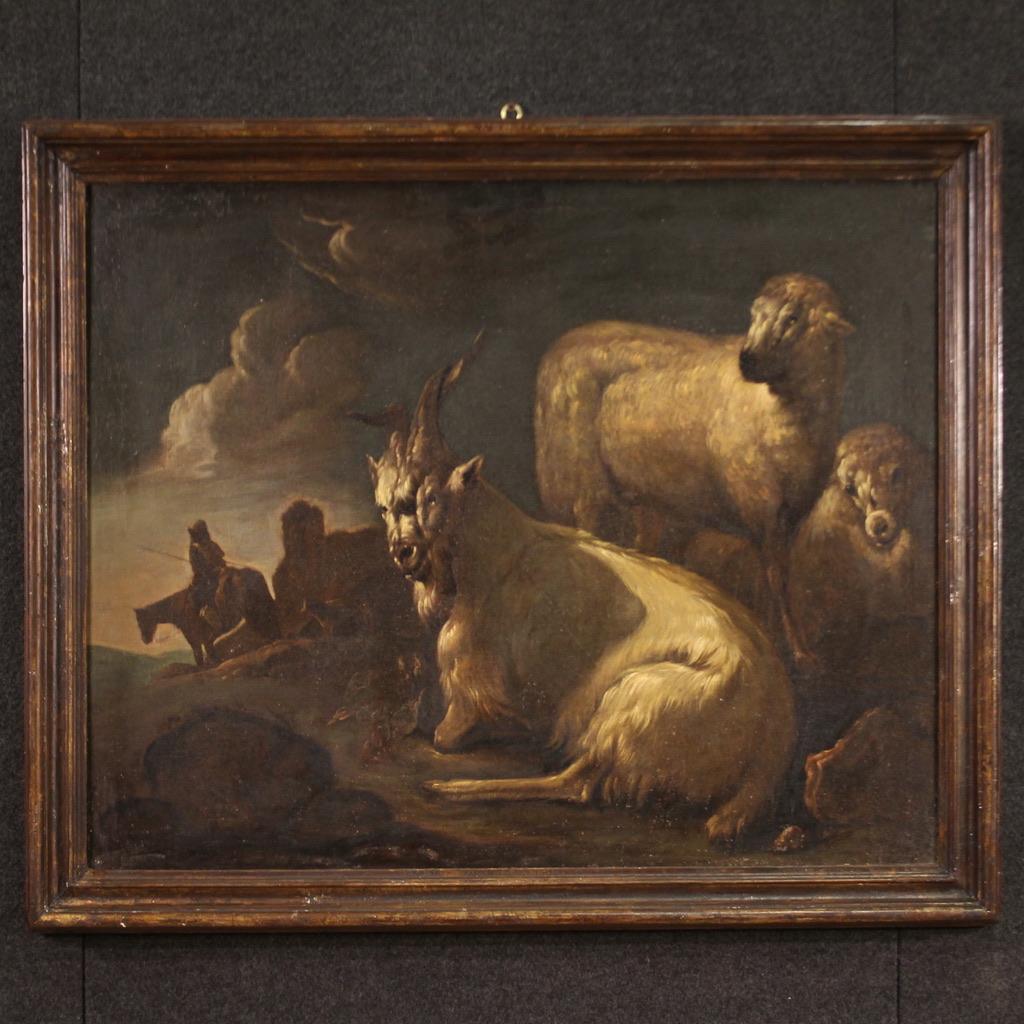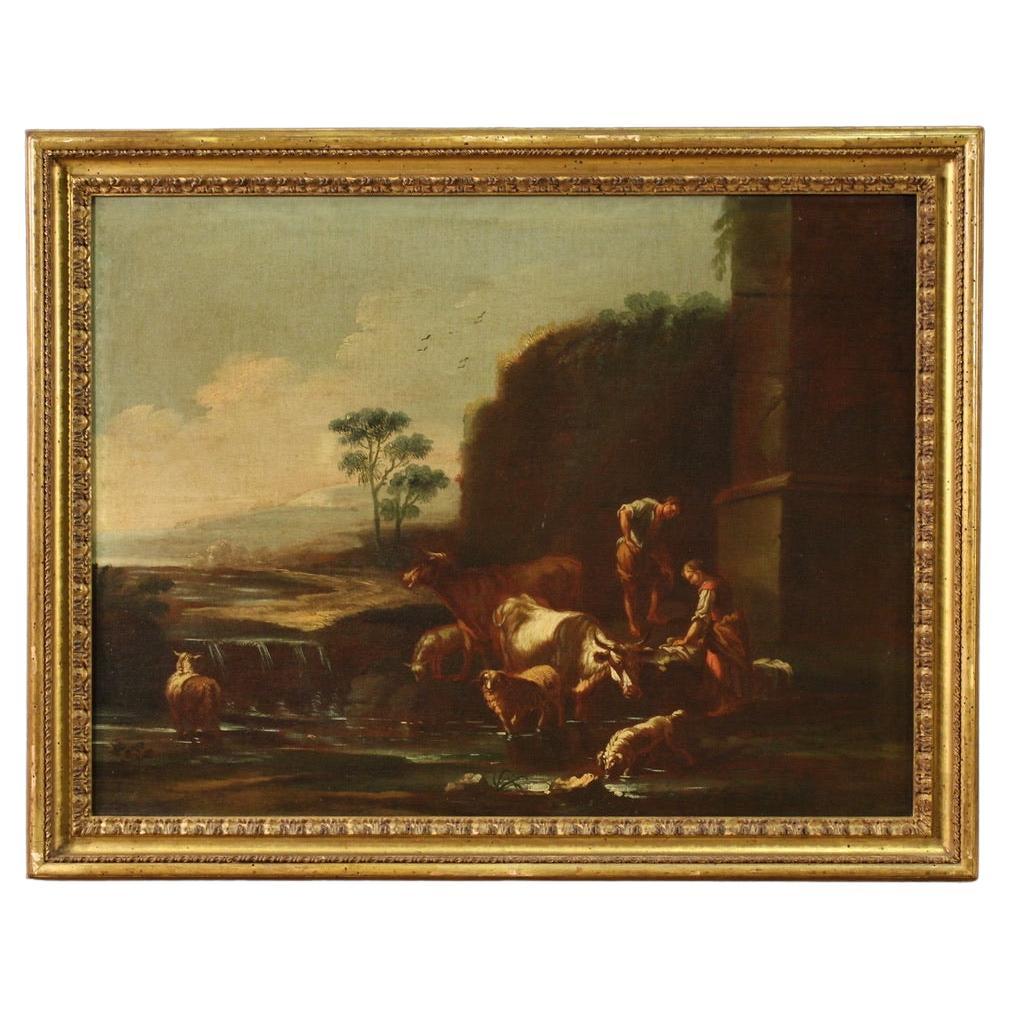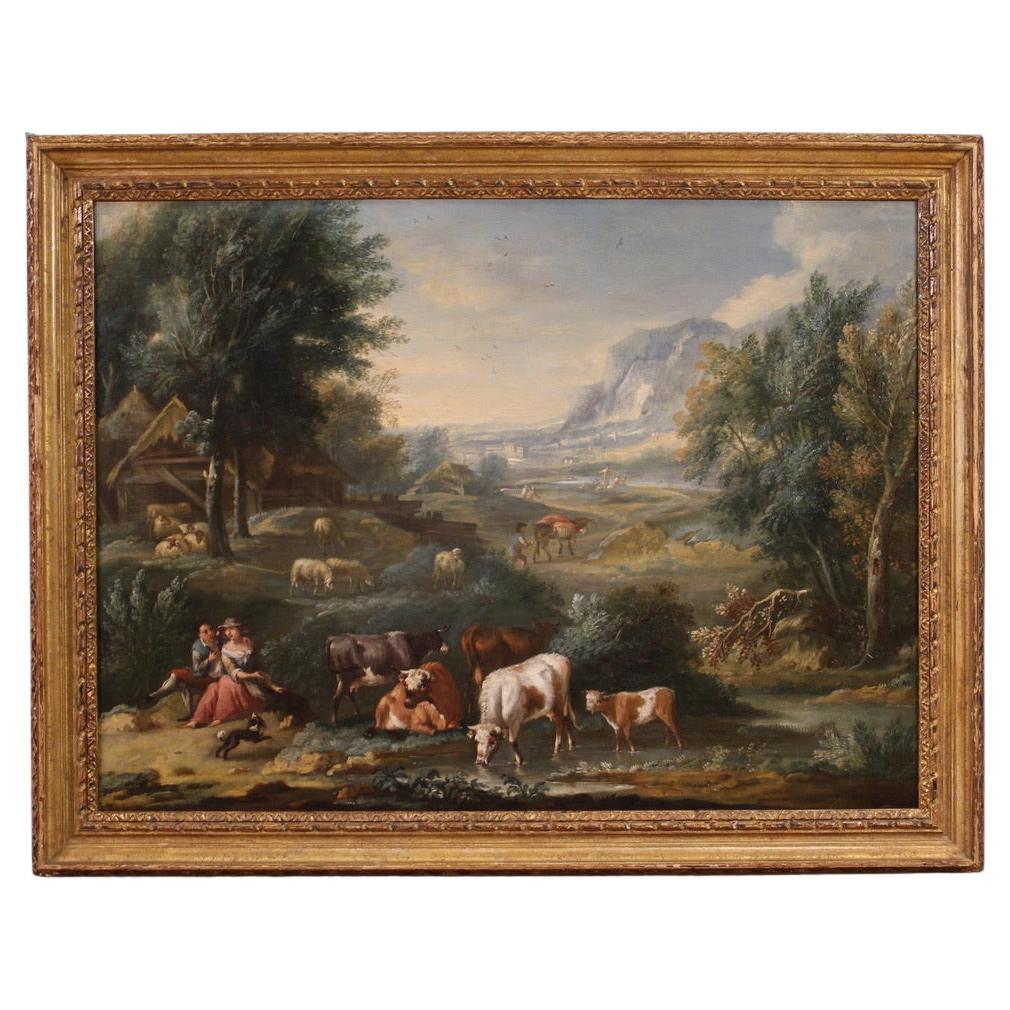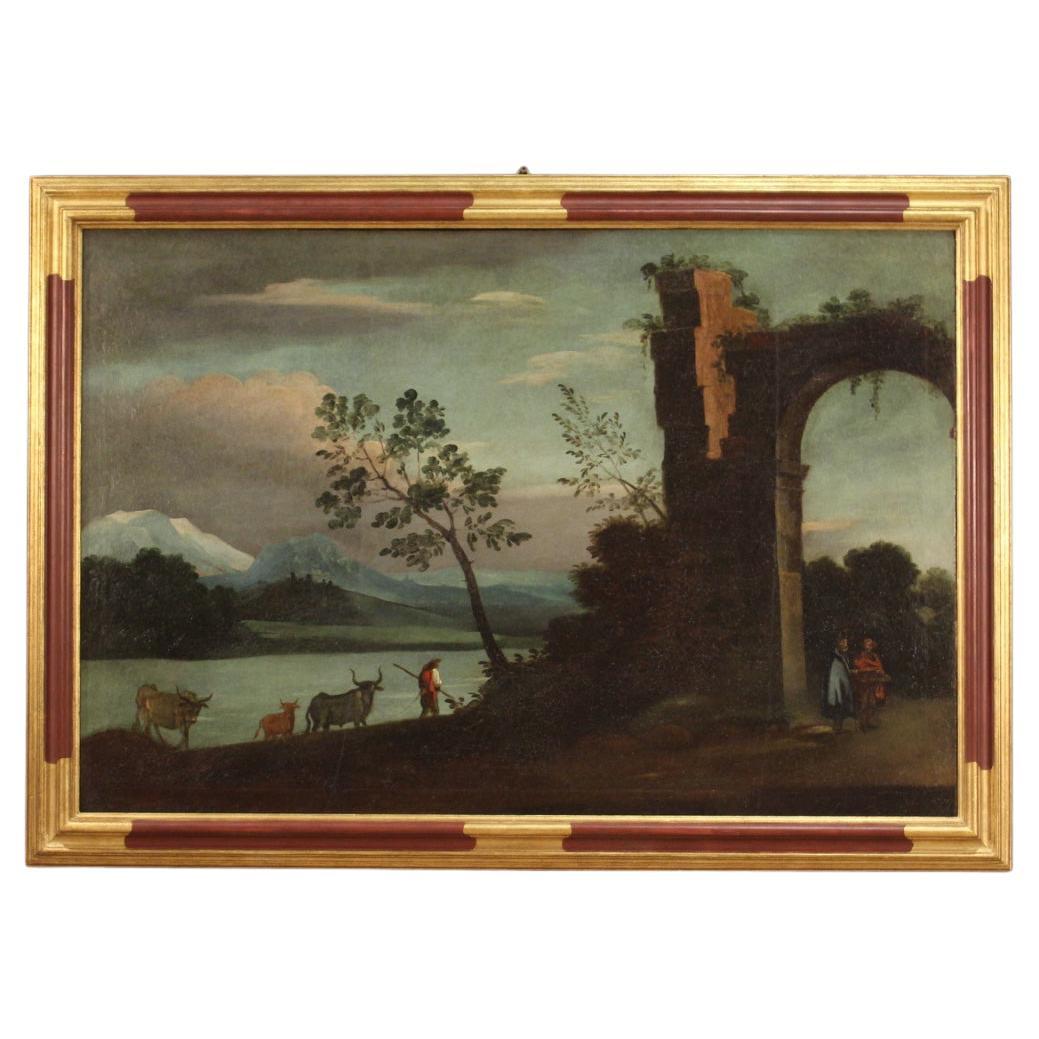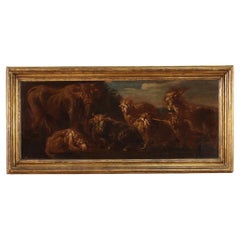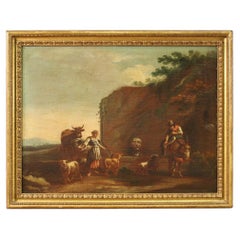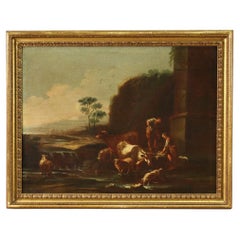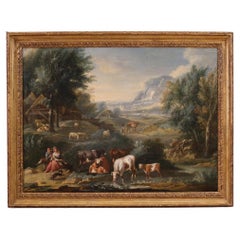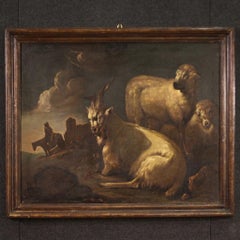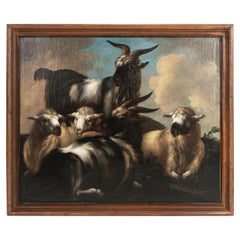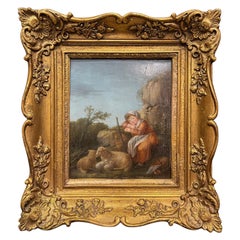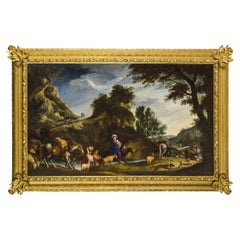Items Similar to 17th Century Oil on Canvas Italian Landscape with Goats Painting, 1680
Want more images or videos?
Request additional images or videos from the seller
1 of 16
17th Century Oil on Canvas Italian Landscape with Goats Painting, 1680
$4,425.83
£3,352.67
€3,800
CA$6,131.39
A$6,876.76
CHF 3,601.25
MX$83,559.35
NOK 45,729.89
SEK 43,355.15
DKK 28,932.31
About the Item
Antique Italian painting from the second half of the 17th century. Painting oil on canvas depicting a particular subject Grazing animals of good pictorial quality in the style of Rosa da Tivoli. Painting that develops horizontally, of interesting size and proportion, adorned with an antique wooden frame, not coeval, carved and gilded. This artwork can be easily placed in different parts of the house, for antique dealers, interior decorators and collectors of genre paintings. Painting characterized by a dark shade depicting numerous goats and a bovine lying in the lower right corner (see photo). Painting that has undergone a conservative restoration, relining, replacement of the frame and color recovery in some points (see photo). Painting that is part of a pair (see photo and ask for the price of the pair if available). In good condition. Sight size H 37.5 x W 97.5 cm.
- Dimensions:Height: 20.87 in (53 cm)Width: 44.49 in (113 cm)Depth: 1.97 in (5 cm)
- Materials and Techniques:Canvas,Oiled
- Place of Origin:
- Period:1680-1689
- Date of Manufacture:1680
- Condition:Repaired: Painting that has undergone a conservative restoration, relining, replacement of the frame and color recovery in some points. Wear consistent with age and use.
- Seller Location:Vicoforte, IT
- Reference Number:Seller: 104421stDibs: LU1848345423252
About the Seller
5.0
Vetted Professional Seller
Every seller passes strict standards for authenticity and reliability
Established in 2004
1stDibs seller since 2016
215 sales on 1stDibs
Typical response time: <1 hour
- ShippingRetrieving quote...Shipping from: Vicoforte, Italy
- Return Policy
Authenticity Guarantee
In the unlikely event there’s an issue with an item’s authenticity, contact us within 1 year for a full refund. DetailsMoney-Back Guarantee
If your item is not as described, is damaged in transit, or does not arrive, contact us within 7 days for a full refund. Details24-Hour Cancellation
You have a 24-hour grace period in which to reconsider your purchase, with no questions asked.Vetted Professional Sellers
Our world-class sellers must adhere to strict standards for service and quality, maintaining the integrity of our listings.Price-Match Guarantee
If you find that a seller listed the same item for a lower price elsewhere, we’ll match it.Trusted Global Delivery
Our best-in-class carrier network provides specialized shipping options worldwide, including custom delivery.More From This Seller
View All17th Century Oil on Canvas Italian Landscape with Animals Painting, 1680
Located in Vicoforte, Piedmont
Antique Italian painting from the second half of the 17th century. Artwork oil on canvas depicting a particular subject Grazing animals of good pictorial quality in the style of Rosa...
Category
Antique 1680s Italian Paintings
Materials
Canvas
17th Century Oil on Canvas Italian Bucolic Landscape Painting, 1680
Located in Vicoforte, Piedmont
Roman school of the second half of the 17th century. Oil painting on canvas depicting a wonderful pastoral scene with figures and animals at the fountain. In the center of the painti...
Category
Antique 1680s Italian Paintings
Materials
Canvas
17th Century Oil on Canvas Italian Antique Landscape Painting Pastoral Scene
Located in Vicoforte, Piedmont
Antique Italian painting from the second half of the 17th century. Oil on canvas artwork depicting a splendid bucolic landscape with figures and grazing animals, of remarkable pictor...
Category
Antique 1680s Italian Paintings
Materials
Canvas
18th Century Oil on Canvas Italian Bucolic Landscape Painting, 1770
Located in Vicoforte, Piedmont
Venetian school of the second half of the 18th century. Oil painting on canvas depicting an Arcadian landscape of pastoral genre. This type of pictorial representation established it...
Category
Antique 1770s Italian Paintings
Materials
Canvas
18th Century Oil on Canvas Italian Antique Landscape Painting, 1750
Located in Vicoforte, Piedmont
Antique Italian painting from 18th century. Framework oil on canvas, on the first canvas, depicting a view with characters, animals and ruins of good pictorial quality. Large size fr...
Category
Antique 1750s Italian Paintings
Materials
Canvas
18th Century Oil on Canvas Italian Painting Landscape Pastoral Scene, 1750
Located in Vicoforte, Piedmont
Antique Italian painting from the 18th century. Artwork oil on canvas depicting pastoral scene, bucolic landscape with animals and popular characters of good pictorial quality. Paint...
Category
Antique 1750s Italian Paintings
Materials
Canvas
You May Also Like
17th Century Oil on Canvas Italian Antique Painting Landscape with Goats, 1680
By Philipp Peter Roos (Rosa di Tivoli)
Located in Vicoforte, IT
Antique Italian painting from the second half of the 17th century. Oil on canvas artwork depicting a splendid bucolic landscape with animals and a shepherd, of great pictorial qualit...
Category
1680s Landscape Paintings
Materials
Canvas, Oil
Large 18th Century Oil-on-Linen Framed Painting
Located in Houston, TX
Large 18th century oil-on-linen framed painting: pastoral scene of sheep and goats at rest, probably Italian. Framed (listed dimensions include frame).
Category
Antique Late 18th Century Italian Paintings
Materials
Linen, Wood
18th Century British Oil on Board Sheep Painting Attributed to F. Wheatley
By Francis Wheatley
Located in Dallas, TX
Created in England and attributed to Francis Wheatley (1747-1801), the oil on panel depicts a young shepherdess attending her sheep and lambs in a pastoral landscape. The colorful ar...
Category
Antique Late 18th Century English Paintings
Materials
Wood, Giltwood
17th Century, Italian Painting by Pier Francesco Cittadini, Jacob and his Family
Located in IT
Pier Francesco Cittadini (Milan, 1616-Bologna, 1681)
"Jacob and his family go to Egypt"
Oil on canvas, cm 109 x 190 (canvas only)
The valuable painting, made in oil on canvas, depicts Jacob and his family go to Egypt and we believe it can be, given the high quality painting, autograph work of Italian Pier Francesco Cittadini (Italy Milan, 1616 - Bologna, 1681) made after 1647. The work, in excellent condition is accompanied by a coeval frame in wood finely carved and golden.
The scene depicted, which was confused with the Flight to Egypt in the past years, is instead identified with the biblical episode of Jacob’s journey. In the foreground, reading the painting from left to right, we see a caravan composed of animals, including donkeys, dromedaries, goats, dogs and horses and people, women, men and slaves, who carry on their journey along the banks of a river, following a path that to the right, would seem to lead to the through of a bridge. In addition to the watercourse is described an environment characterized by large rocks and impervious come far to cover the entire verticality of the canvas. On the left, in the distance, we see the tail of the caravan that runs along the steep path. Large trees enliven and harmonize the environment, as well as white and grey clouds characterize the predominantly clear sky and illuminated on the right by sunlight.
The story is told in the Bible, Book of Genesis, 30, 25, passage in which is described the flight of Jacob from Haran after the contrasts with Laban, father of his wife Rachel. Jacob is the third great patriarch of the Bible. From his descendants originate the twelve generations of the people of Israel. He is the son of Isaac and Rebekah, who led him to flee from the wrath of Esau to Haran to seek refuge from his brother, Laban. At his uncle’s house Jacob met his daughter Rachel. As soon as he saw his cousin, Jacob was taken. Jacob will stay seven years in the service of Laban to marry his beloved Rachel. But Laban, with a deception, will give him in marriage first Lia, the least beautiful eldest daughter, and only after another seven years the splendid Rachel. From his first wife he will have several children, while Rachel will give birth to the beloved son, Joseph, who will become viceroy of Egypt.
After years of service, Jacob asked to be paid with every dark-coloured garment among the sheep and every spotted and dotted garment among the goats. Laban accepted and sent away from his sons all the leaders of that kind. So Jacob took fresh branches of poplar, almond and plane tree, and flayed them, and put them in the troughs. The optical suggestion induced the goats and the sheep to conceive and give birth to dark, striped and dotted garments. He also ensured that all the strongest and healthiest leaders of the flock of Laban would drink near the barked branches, thus assuring a genetic superiority to his part of the flock. His flocks grew numerous and strong and he became richer than his relative, arousing envy. It was clear that Laban would not respect him much longer. At the suggestion of the Lord, Jacob decided to return to Canaan. Trying to avoid any possible dispute, he left with his family while Laban was absent for shearing sheep. But when, three days later, his uncle returned home, he became angry, feeling offended because Jacob had gone secretly and had not allowed him to greet his daughters and grandchildren. In addition, his teraphim, statuettes, or idols, which depicted the family deities, had disappeared. After 7 days of pursuit, Laban and his men reached Jacob’s group on Mount Gilead, in the mountainous region west of the Euphrates River, where his uncle and grandson had a stormy conversation. The younger man was outraged at being accused of stealing idols and told Labano to rummage through his family’s tents at will. Neither of them could know or even imagine that it was Rachel who took the idols and hid them in the saddle of the camel. During the search, she sat down firmly on the saddle, apologizing for not being able to get up, «because I usually have what happens to women» (Gen 31:35). So the loot wasn’t discovered.
The author of this work was inspired by the composition of an engraving by Stefano Della Bella (1610-1664) of circa 1647. The engraving by Stefano della Bella bears the title "Iacob sur ses vieux jours quitte sans fascherie pour voir son filz Ioseph, sa terre et sa patrie" and is signed on the bottom left "Stef. of the Beautiful In. et fe." while on the right it is declared "Cum privil. Regis", that is with license of the king.
Stefano Della Bella (Italy - Florence, May 18, 1610-Florence, July 12, 1664) was born in a family of painters, sculptors and goldsmiths and was left early orphan of his father sculptor, he dedicated himself first to the art of goldsmith at the school of Giovanni Benedetto Castiglione and Gasparo Mola, then turning his attention to drawing and engraving. He soon began drawing figures and copying the etchings of Jacques Callot, which inspired his early works. Under the protection of the Medici, in particular of Don Lorenzo, cadet son of Grand Duke Ferdinand I, Della Bella has the opportunity to make study trips to Rome, where he stayed from 1633-1636; In Rome he met French engravers and publishers of prints such as Israël Henriet and François Langlois, who influenced his decision to move to Paris in 1639, four years after the death of Callot. In Paris he soon reached, thanks to the engravings commissioned by Cardinal Richelieu, the success also worldly; he frequented courtiers, theatre artists and writers, while refusing too oppressive honors. In 1646-1647 he continued his travels in the Netherlands to Amsterdam, Antwerp and Dordrecht. He returned to Florence in 1650 and resumed working under the protection of the Medici court, working for his patrons. In 1656 he became a member of the Academy of Apatists.
The painting object of this study is reasonably attributable to Pier Francesco Cittadini, or Pierfrancesco Cittadini, called the Milanese or the Franceschino (Italy - Milan, 1616-Bologna, 1681) as some exemplary stylistic comparisons proposed to follow can prove.
Pier Francesco Cittadini was an Italian baroque painter, mainly active in Bologna.
His artistic training first took place with the painter Daniele Crespi...
Category
Antique Mid-17th Century European Baroque Paintings
Materials
Canvas, Giltwood
17th Century, "Shepards Solace Among The Flock" Flemish School Oil
Located in Atlanta, GA
This exquisite oil painting, is a masterful depiction of a pastoral scene that epitomizes the serene beauty of rural life. Likely created in the 17th century, the work surely of Flem...
Category
Antique 17th Century Belgian Baroque Paintings
Materials
Canvas, Giltwood, Paint
17th Century Architectural Capriccio with Herds Painting Oil on Canvas
Located in Milan, IT
Circle of Nicolaes Berchem (1620, Haarlem - 1683, Amsterdam)
Architectural capriccio with herds
Oil on canvas, 57.5 x 74 cm
With frame 76 x 93 cm
The examined canvas is...
Category
Antique 17th Century Dutch Paintings
Materials
Canvas
